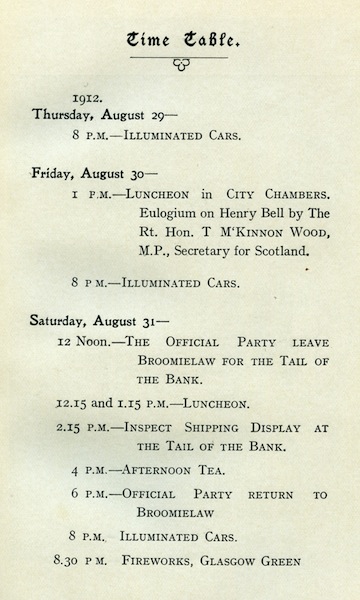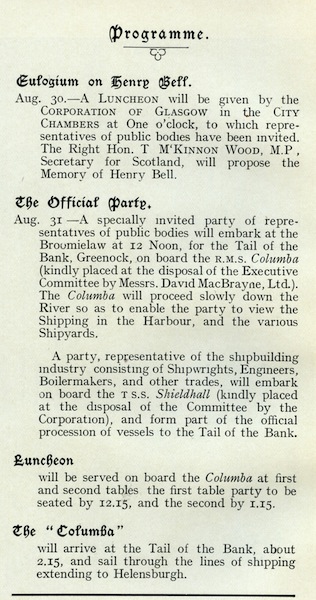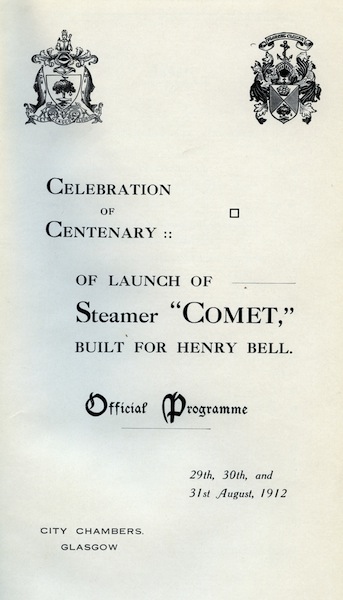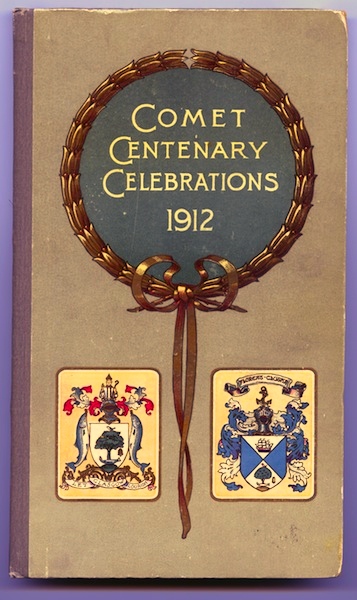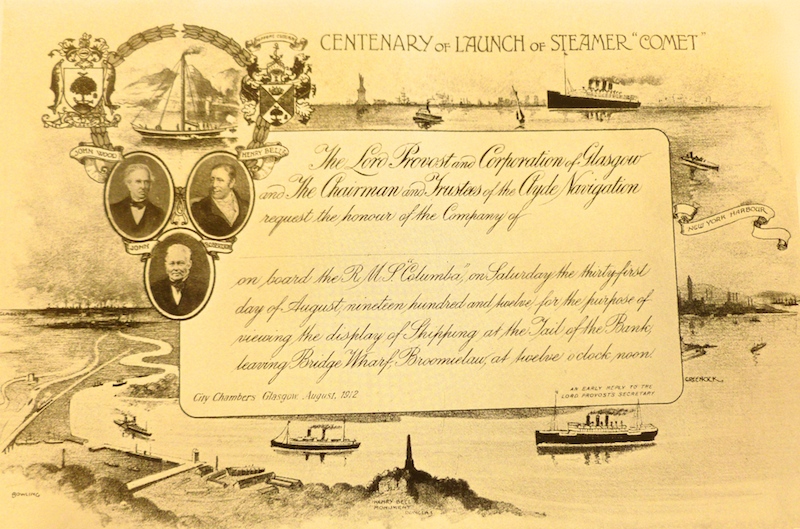
Comet centenary: in August 1912 the City of Glasgow Corporation sent out invitation cards to honoured guests for the special downriver sailing by Columba to commemorate the pioneering steamer
Rarely did MacBrayne’s Columba deviate from the Ardrishaig run, to which she was thirled throughout her 57-year career. One of the most notable exceptions to her routine was on the last day of August 1912, when the Clyde’s greatest paddle steamer led the tributes to her pioneering forebear of 1812. Colin Tucker tells the story:
No fewer than 127 harbour towns – from Applecross to Arbroath, from Wemyss Bay to Wick – had been asked to display flags and bunting on Saturday 31st August 1912. The reason? To celebrate the centenary of the launch of Henry Bell’s Comet, the world’s first mechanically powered vessel to operate in open waters.
On the Clyde much more elaborate arrangements were made to mark the event, and the centrepiece of these was RMS Columba. A display of shipping was held off the Tail of the Bank, and Columba was to be the inspecting steamer.
Invitations were sent out from the Lord Provost of the Corporation of Glasgow and the Chairman and Trustees of the Clyde Navigation to selected representatives of public bodies to view the shipping from the decks of Columba, ‘kindly placed at the disposal of the Executive Committee (specially formed for the occasion) by Messrs David MacBrayne Ltd.’
A second party, consisting of shipwrights, engineers, boilermakers and other shipbuilding trades, was invited to embark on TSS Shieldhall, to form part of the official procession. This vessel was placed at the disposal of the Committee by the Corporation.
Amongst the other ships to follow Columba in the procession was Queen Empress, chartered by the Glasgow and West of Scotland branch of the Navy League.
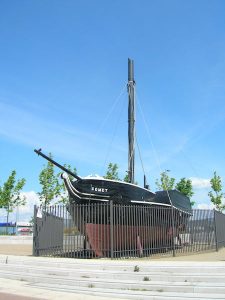
The Comet replica at Port Glasgow, built in 1962 to mark the 150th anniversary of the first sea-going steamship — copyright CRSC Archive Collection
Columba departed from Bridge Wharf at 12 noon. She proceeded ‘slowly down the River so as to enable the party to view the shipping in the Harbour, and the various Shipyards.’ It is interesting to note that in 1912 there were no fewer than 35 shipyards and about 175 ships either on the stocks or fitting out.
On their way down the river those lucky enough to be on board were served lunch, ‘with the first table party to be seated by 12.15 and the second by 1.15.’ This meant that everyone had finished eating by the time Columba arrived at the Tail of the Bank around 2.15.
The mighty paddler then made her way through the lines of ships, which extended across to Helensburgh, anchored in seven lines running approximately east to west. The most southerly line consisted of the battleships Hercules, Colossus and Monarch. In the next lines merchant shipping were anchored. These represented 20 different shipping companies, ranging from the Anchor Line and the Clan Line to G. & J. Burns, Laird Line and the Clyde Shipping Company. Other vessels included yachts, motor boats, tugs, hopper barges and a dredger. Off Helensburgh was a line of battleships and cruisers, and two destroyers.
It was through these ships that Columba and her followers sailed. There were strict instructions to be followed. Anchored ships were to be ‘dressed with flags according to the facilities at their disposal’, and to salute Columba by dipping their ensigns as she passed.
This salute was to be returned by Columba, steaming slowly with the ships on her starboard side, until all the ships in the display had been inspected. Columba took precedence over all other vessels under way, which had to proceed with caution, and not overtake or pass others in the line. Between 2pm and 4pm yachts and other craft were not to pass through the lines, while rowing boats were to keep close to the vessels at anchor!
During the inspection those on board Columba were entertained by W. H. Cole’s Orchestra, which played a selection of 20 numbers. Some, such as ‘On the Rolling Sea’ and a selection of melodies from Gilbert and Sullivan’s HMS Pinafore, had a nautical theme; others were more obscure – an Indian Romance, Egyptian ballet Music and a Fantasia entitled ‘A Highland Scene’.
After the inspection was completed high tea was served at 4pm, following which Columba sailed to Gourock and Princes Pier, ‘where those desirous of doing so may disembark’. The steamer then made her way back up the Clyde, returning to the Broomielaw at 6 pm.
For a ship which spent almost the whole of her career sailing from Glasgow to Loch Fyne this must have been a rare diversion. The fact that she was chosen for this duty also emphasises the importance of Columba and the esteem with which she was held.
Catch up will all CRSC’s previous posts by clicking on News & Reports.
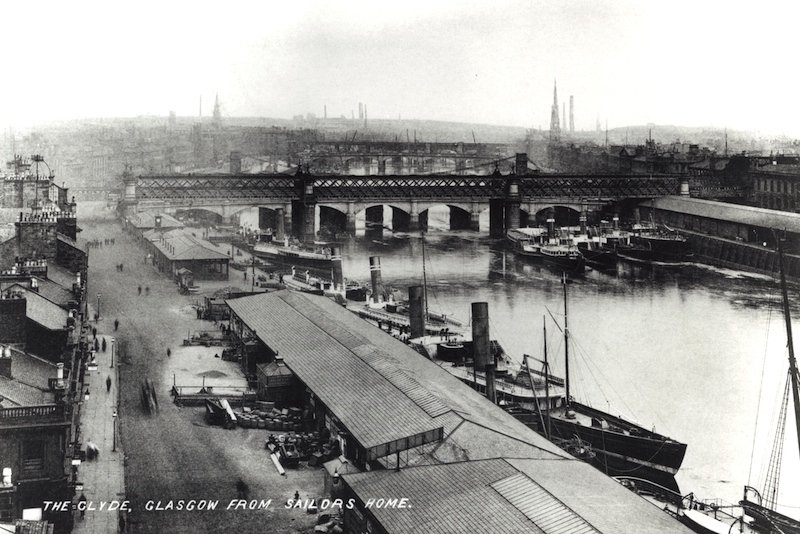
Columba (foreground) at the Broomielaw c1900, berthed ahead of Lord of the Isles and Culzean Castle, with Isle of Arran and Edinburgh Castle moored outside two other steamers on the opposite side
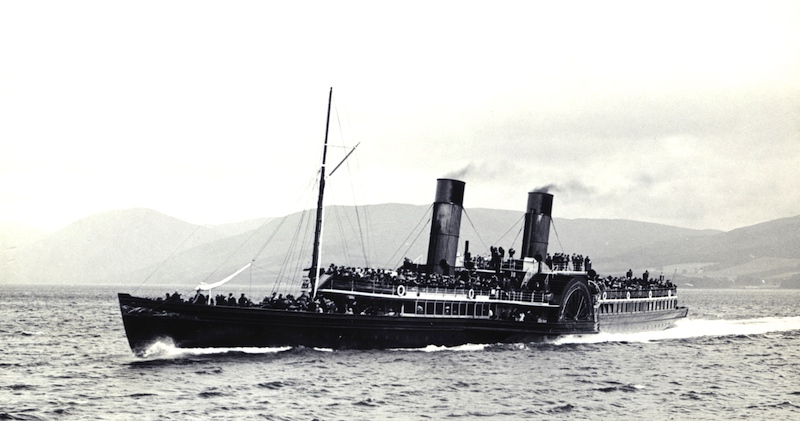
The Comet centenary cruise on Saturday 31 August 1912 was a notable deviation from Columba’s routine of sailing daily except Sundays to Ardrishaig. She is pictured entering Rothesay Bay on 3 August 1903 — copyright CRSC Archive Collection
EXTRACTS FROM GLASGOW CORPORATION’S COMET CENTENARY BOOKLET reproduced courtesy of John Newth
